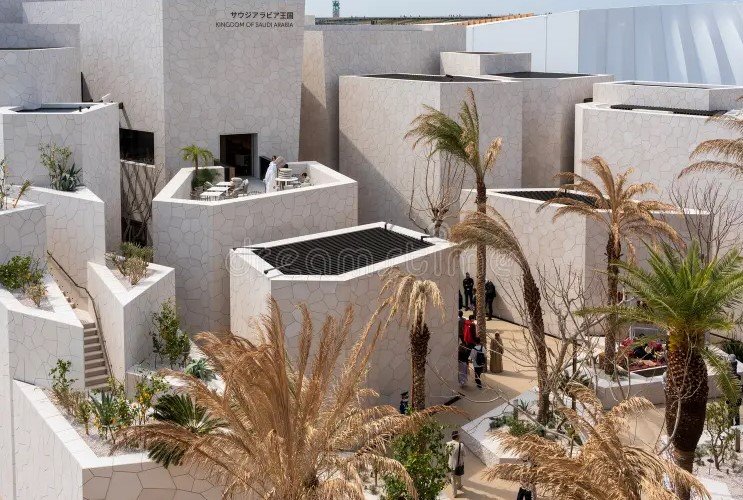The Saudi Ministry of Culture is putting on quite the show in Osaka this week — a four-day celebration that wraps history, hospitality, and heritage into a vibrant cultural offering, marking 70 years of diplomatic ties between Saudi Arabia and Japan.
From July 12 to 15, visitors to Expo – Gallery EAST will get more than just exhibitions — think live oud performances, hands-on calligraphy, and the aroma of Arabic coffee drifting through a traditional Saudi majlis. It’s not just about sharing culture; it’s about building real human connections across borders.
A Cultural Exchange That Feels Personal, Not Just Official
This isn’t some stiff diplomatic function. It’s warm, immersive, and quietly emotional. The Saudi Cultural Week in Osaka comes at a time when global events are often filtered through screens — this is refreshingly in-person, sensory, and grounded.
Japan and Saudi Arabia first established diplomatic relations in 1955. Seventy years later, the bond is still evolving, and this cultural week reflects a friendship that’s matured beyond trade or treaties.
The Saudi Ministry of Culture has teamed up with heavyweight institutions — the Heritage Commission, Wrth (Royal Institute of Traditional Arts), the Arabic Calligraphy Center, and others — to give visitors a chance to feel Saudi Arabia rather than just read about it.

Inside the Majlis: Warmth, Music, and Hand-Poured Gahwa
The beating heart of the exhibit is the Saudi Heritage Majlis — a cozy, traditional gathering space recognized by UNESCO. Step inside and you’re greeted not by a guard or a guidebook, but by someone offering coffee, dates, and a smile.
There’s something unspoken about that kind of welcome.
One of the most moving elements? A live oud performance softly echoing across the space, paired with the gentle plucking of the Japanese shamisen. Two string instruments from two worlds, finding harmony in a gallery in Osaka.
You don’t have to understand Arabic or Japanese to feel the emotion in that room.
Crafts That Tell Stories Without Saying a Word
There’s beauty in the quiet details — in the threads of Sadu weaving, or the soft shape of a clay bowl formed by hand.
This is the stuff of memory — how grandparents passed time, how stories were shared before television and TikTok.
Midweek visitors will catch artisans performing live demonstrations of:
-
Palm frond weaving, an age-old craft once essential to desert life
-
Sadu, the colorful geometric textile style used in tents and garments
-
Arabic calligraphy, fluid and poetic
-
Pottery, shaping the past into present-day art
Every artisan has a story, every item holds history.
A Pavilion That’s More Than a Building
Beyond the main exhibition area, the Saudi Pavilion at the Expo site stays open through the entire four-day stretch. And no — it’s not just a bunch of framed photos or museum-style plaques.
Instead, it feels lived-in. There’s rhythm and flavor. Conversations bubble up spontaneously. Visitors linger, not because they have to, but because they want to.
Tables of Saudi snacks appear out of nowhere. A booth selling handmade souvenirs draws smiles. Language barriers? Barely noticeable, thanks to warm gestures and helpful guides floating through the space.
One visitor said, “I came for 15 minutes… ended up staying for two hours.”
Celebrating the 70-Year Saudi–Japan Relationship With Something Real
It’s easy to forget how long 70 years is. It’s a whole lifetime. And yet, many people in Osaka — especially younger ones — may have never met a Saudi national, or tasted kabsa, or heard Arabic spoken.
Events like this help close that gap, quietly and meaningfully.
Here’s a quick look at how far things have come between the two nations:
| Year | Milestone in Saudi–Japan Relations |
|---|---|
| 1955 | Diplomatic ties formally established |
| 1975 | First bilateral trade agreement signed |
| 2017 | Crown Prince Mohammed bin Salman visits Tokyo |
| 2023 | Japanese firms expand renewable energy deals in Saudi Arabia |
| 2025 | 70th anniversary celebrated in Osaka |
This Cultural Week isn’t about flashy politics or trade deals. It’s soft diplomacy — but done right.
Beyond Art: It’s the People Who Made It Count
What you don’t see on the event schedule is just as important.
A Saudi grandmother weaving palm leaves while joking with a Japanese teenager. A quiet translator helping two artists talk about the curve of a brushstroke. A shared laugh over which coffee is stronger.
Those moments are the glue of this whole thing.
No press release will capture that. No government statement can replicate it.
But ask the people who showed up, who shook hands, who swapped stories — and they’ll tell you. This wasn’t just an event. It was something special.
